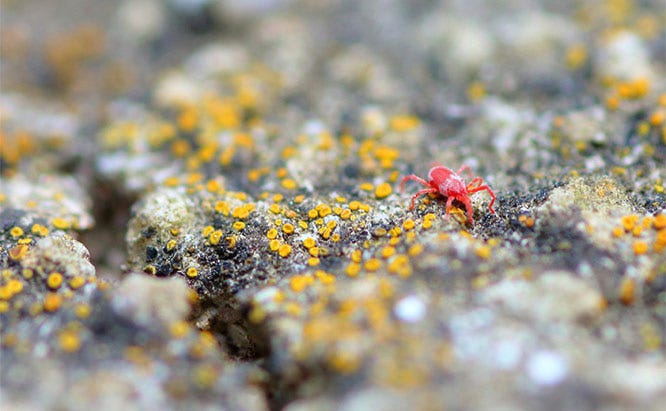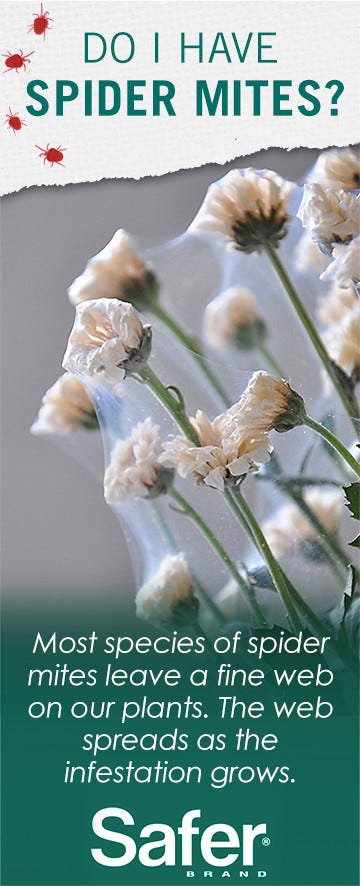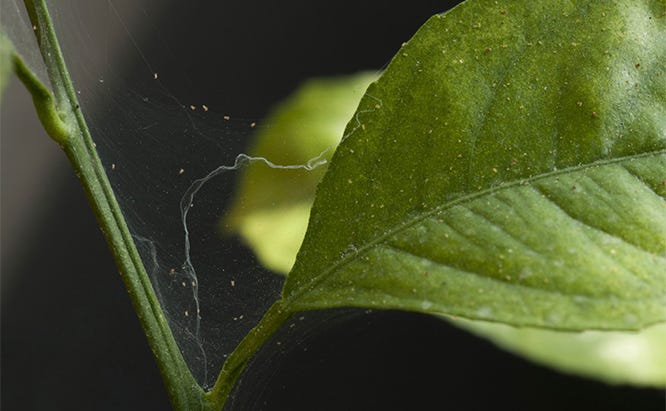
Outdoor plants face the same threat from spider mites – left to their own devices, spider mites can quickly destroy your favorite plants. Even worse, these arachnids multiply quickly, so multiple treatments are often necessary to appropriately destroy these invaders.
Safer® Brand is ready to help, though. Several OMRI Listed® solutions, which are compliant for use in organic gardening and help treat and destroy spider mites.

Spider mites are tiny arachnids that can devastate a plant.
Often red, these spider-like creatures spin webs and drain a plant of its nutrients.
Spotting a Spider Mite & Its Webbed Plants
The important thing to understand about spider mites is that they are very tiny. The best way to describe how small they are is to take a pencil and quickly tap it on a piece of paper – the mark you left is about the size of a really big spider mite! While they may be small, they are a big danger to your plants.

Most people rarely notice the red-colored spider mites, and when they do, it’s because the tiny creatures contrast so well against plant material. However, there are several varieties of spider mite, some of which are green, yellow or translucent, which make them particularly difficult to detect.
Some common spider mite species are:
- Carmine spider mites (Tetranychus cinnabarinus) – Red or purple mites with white legs.
- European red spider mite (Panonychus ulmi) – Females of this species are brick-red with light-colored legs. Males are yellow or tan.
- Pacific spider mite (Tetranychus pacificus) – A green or amber colored mite.
- Southern red spider mite (Oligonychus ilicis) – This mite is reddish brown with translucence in the legs and toward the front of the body.
- Two-spotted spider mite (Tetranychus urticae) – One of the more common pests, it features a spot on each of its sides, otherwise it’s yellow or clear in appearance.
- Willamette spider mite (Eotetranychus willamettei) – A mite that appears to be translucent or pale yellow.
Regardless of the species, most spider mites live up to their name by spinning a cloak of webbing over the plants they’re infesting. This webbing is used by the mites to move back and forth along the plant, and it will slowly spread across the entire plant structure as these pests move along to undamaged parts of the plant.
What Spider Mites Love
Most spider mites thrive in hot, dry weather and often attack plants that are suffering from a slightly dehydrated state. Spider mites are not too picky with their targets either, and are happy to feed on a variety of plants, including apples, azaleas, camellias, cannabis, boxwoods, hibiscus, holly, pears, pecans, spruces and teas.
Further, spider mites can be trouble inside a building and outside, so keep an eye out for them as they attempt to establish themselves in just about any plant-rich environment, including golf courses, greenhouses, interiorscaping projects, landscaping projects, nurseries, parks and plantations.

While feeding, red spider mites will pierce individual plant cells
and then drain the contents.
How Spider Mites Destroy Plants
Spider mites use their mouthparts to pierce individual plant cells and then drain the contents of the cell. This destructive feeding style creates tiny speckles on plant leaves, usually yellow or white. As the spider mites continue to feed on a particular leaf, the leaf takes on a bronze coloration. After damage accumulates on a particular leaf, it dies and drops off the plant.
Heavily infested plants will often be covered with webs, become discolored, face stunted growth and may eventually be killed off by the spider mite population as it slowly defoliates the entire plant.
Ultimately, spider mites are difficult-to-treat plant pests for three reasons:
- Small size – Since spider mites are so small they are hard to see, even an observant gardener can miss these tiny creatures. This gives the mites more time to establish themselves. There can be dozens of crawling on a plant before they are noticed.
- Feeding habits – Coupled with their tiny size, spider mites further their imperceptible assault by feeding on the underside of plant leaves. This makes them hard to spray for humans and difficult to reach for some predators.
- Reproductive rates – Spider mites are speedy breeders. In some species, a new generation of spider mites is born every five days. Spider mite females can lay hundreds of eggs over their month-long lifespan. At this rate, they can quickly overrun an entire crop.
Where Do Spider Mites Come From?
Nearly all the spider mites infesting a garden or greenhouse or houseplant were probably born there. Spider mites only live about a month, and they often spend their entire lives on one plant.
They are transferred to new plants by people and animals when they brush past an infested plant. Further, they may move from one plant to another if the plants touch leaves. Finally, spider mites may crawl or drop off a plant with a heavy infestation and move on to another.
Also, spider mites may be introduced to a new environment when a gardener brings in new plants from an outside source or adds soil or mulch that came from underneath an infested plant.

Spider mites can travel from plant to plant if they touch leaves.
To control spider mite infestations, keep plants separated.
Fighting Spider Mites
The absolute best method for fighting spider mites in any situation is to detect them early in their infestation. Doing so allows you to take immediate measures before they begin to spread to additional plants. Additionally, it allows you to address the problem before their breeding cycle switches into high gear.
To inspect for spider mites, regularly examine the leaves of your plants for the spotting that occurs when these pests feed. If you discover any damage, use a magnifying glass to check the undersides of the damaged leaves where you are most likely find spider mites.
Another method of detection is to hold a white sheet of paper under a plant. After you give your plant a good shake, check out the paper again. If you see little red dots on the paper, then you probably have spider mites.
Once you’ve determined that you have a spider mite problem, you can try beating them in any of the following ways:
- Solution: Spot Treatments – Sprays, including OMRI Listed® Safer® Brand Insect Killing Soap, should be kept on hand to deal with spider mites as you discover them during your daily survey of plant health. Just blast the plant with a few squirts to protect it for seven to 10 days. Safer® Brand End ALL® is another helpful treatment for spider mites and other pests – just coat the plant surface with this insect-killing solution of Neem oil, pyrethrin and potassium salts of fatty acids.
- Solution: Rinsing – One of the easiest ways to eliminate a spider mite invasion is to thoroughly rinse off the infected plants. The force of the water actually appears to kill spider mites. The only hitch is that you have to spray the water where the spider mites are – on the underside of the leaves. That requirement can make this treatment a very time consuming task.
- Solution: Drowning – For use with houseplants and other plants in small pots. Take your plant, pot and all, and lay it down in a bathtub or basin that can hold the entire plant. Weigh the leaves and branches down so they don’t float. Then fill the tub with 90-degree water. After the plant has remained under water for 1 hour, tip the plant up and allow all the water to drain from the tub and the pot. Scoop up any dirt and add it back into the pot. The process drowns spider mites and their eggs. For the most part your plant should be fine, although be aware that certain plant species may react poorly to an extended dunking!
- Solution: Mite Predators – One green method for spider mite control is to recruit some spider mite predators. Phytoseiulus persimili is a predator mite that preys on its cousins. They are very thorough in their efforts and only prey on a few, specific species. Once they exhaust their food supply, the remaining predators will starve to death, which may start the infestation all over again.

Spider Mite killer, such as Safer Brand Insect Killing Soap,
can eliminate a spider mite infestation.
How Are You Beating Spider Mites?
Have spider mites hit your garden? Let us know about the infestation in the comments below or the next time you visit Safer® Brand on Facebook.
You can learn more ways to protect your plants by subscribing to the Safer® Brand E-Newsletter, which lawn and household tips as well as links to the OMRI Listed® pest control products you need.



